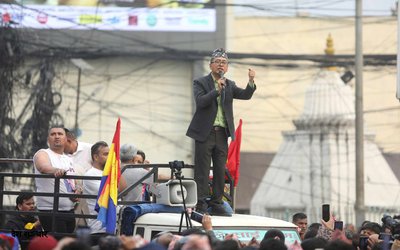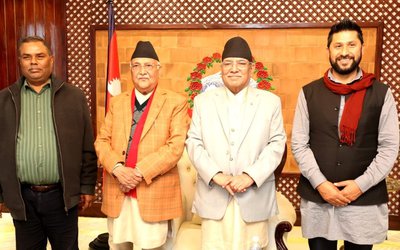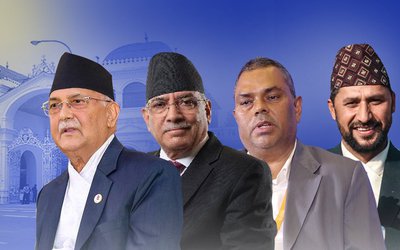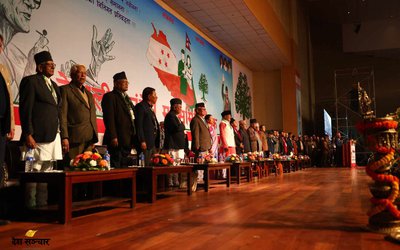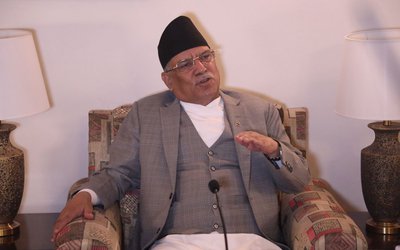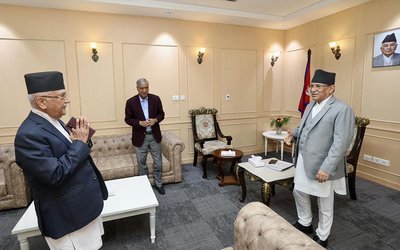“Bring any constitution or any political system, it is doomed to fail in Nepal. Constitution and political system has nothing to do with Nepal’s internal political crisis,” said eminent constitutional lawyer Ganesh Raj Sharma, who was part of all leading political and constitutional debates over the past three decades.
Sharma defended in the court as a lawyer on behalf of leaders from B.P. Koirala to G.P. Koirala and from former prime minister K.I. Singh to other leading political figures, bureaucrats, businessmen and several other prominent figures. He retired from active profession three years ago before which he used to argue that constitution and political system had nothing to do with Nepal’s political instability and crisis.
“Situated in a very sensitive geo-political location, Nepal has certain inherent defensive shield and continuous crisis. Its defensive shield is guaranteed by its own time tested space from the east to west border. However, geo-political contact between two big powers generates complications resulting in frequent political instability and crisis. As Prithivi Narayan Shah the great identified Nepal as a yam between two boulders, it is relevant forever,” Sharma wrote in his last article in Himal Khabar Patrika in 2008.
Experience in CA
As fewer than four months are left for the extended tenure of the Constituent Assembly to end, there is no sign that the CA will promulgate the new constitution. More than 72 disputed issues, including form of government, structure of state, preamble and fundamental rights, remain to be settled. There are bundles of differences making it almost sure that the new constitution will not be accepted by all.
“Our party’s central committee has already draw the conclusion that this Constituent Assembly cannot write the constitution as par the wishes of the people. This Constituent Assembly has no utility for us. After seriously analyzing the situation, we will promulgate People’s Constitution from outside the Constituent Assembly,” said Ram Bahadur Thapa Badal, general secretary of Maoist, addressing a closed session of party workers. “Since there require two third majority to pass the new constitution and no single political party has such majority, it is impossible to bring the constitution. We cannot accept NC and UML stand and they will oppose our stand. This will create the stalemate. We have just 40 percent of votes. Supreme Court’s decision was also a part of a design to prevent writing a constitution as Maoist wish. If other parties make efforts to deny our wish, we will go for rebellion.
Even if the new constitution is promulgated, various parties will burn it if it does not endorse their own demands.
“If the new constitution does not recognize one Madhesh and one Pradesh as an autonomous state, it is unacceptable for Madhesh and Madheshi people. It will compel us to take unpleasant steps to the extent of demanding secession. We are demanding five villages as Pandab (main actors of Mahabharata). If our demand is not fulfilled, the new constitution will not be acceptable for us,” thundered Jaya Prakash Ananda Gupta, leader of Madheshi Janadhikar Forum (Republican).
Tharus and other ethnic groups have their own demands. “If the new constitution does not agree on Tharuhat Autonomous state in terai for indigenous community of Terai, we will go for a rebellion. We don’t want to be a part of Madhesh,” said Laxman Singh Tharu, leader of Tharuhat. “The new constitution needs to protect and guarantee the rights of indigenous population like Tharus.”
Six years have already passed since the Jananodlan II, five years after the Comprehensive Peace Agreement and four years after the elections of Constituent Assembly, but Nepal is yet to complete the much needed constitution writing and peace process – two fundamental slogans of current political change.
There are differences over the agenda for Truth and Reconciliation Commission and Disappearance Commission. Maoists are insisting on blanket amnesty. Two prominent members of Transitional Justice committee have already disassociated from the committee. Not only is there a looming danger for the integration process to derail, the disagreement over the transitional justice system is now heading to collapse.
Nepal’s political forces - which led the present political transformations – are in the blame game. “UCPN-Maoist needs to clarify its stand—as to whether it wants democratic constitution or communist constitution,” asked leader of United People’s Forum Chitra Bahadur K.C.
“Maoists alone cannot surrender the political stand. We have made it clear that the constitution needs to address our demand for elected president,” said UCPN-Maoist Dev Gurung.
Frustrated by the failure of political parties to find a sure way to peace and constitution, civil society leaders are calling for an uprising too.
“As they could not complete the peace process in five years and constitution writing in four years, I cannot believe that they will complete both processes now. Political leaders are betraying us,” said prominent civil society leader and former speaker Daman Nath Dhungana. “Given the political situation, I don’t think they will complete the constitution writing and peace process. If they don’t complete the political process, I will call another uprising against them.”
The present political impasse was not a sudden political development. However, it was predicted by political observers when political parties scrapped the functional constitution without any agreement on any fundamental questions on basic features of the new constitution.
The election was held for Constituent Assembly without any understanding and agreement on what should be the basic feature of the new constitution. From forms of the government to structure of the state and already settled constitutional rights like human rights and fundamental rights, political parties are quarreling over so many issues. “Time is running out and the time has come to determine on which theoretical basis we want to formulate the constitution,” said NC leader Ramesh Lekhak.
“Our bottom-line is a directly elected executive president and federal structures based on ethnicity. This is the mandate of the people’s war,” said UCPN-Maoist leader Pushpa Kamal Dahal Prachanda.” “Had we have faith on parliamentary system, we would not have to wage the People’s War.”
Nepali Congress has backed the parliamentary form of government. “The directly-elected presidential system will produce tyranny in the country. Parliamentary system is the best system which has adequate check and balance. This is our final stand,” said Nepali Congress president Sushil Koirala. “We cannot compromise with parliamentary forms.”
CPN-UML has its own choice for the form of government and structure of the state. “Sharing the executive power between directly elected president and prime minister elected by the legislature will be the best solution,” said Jhalanath Khanal.
When they started the course of writing the new constitution through the elected Constituent Assembly, political parties did not have any agreement from top to bottom for the new constitution. Even after four years of elections of Constituent Assembly and six years after scrapping functional constitution, the debates of political parties center around the basic questions of the constitution.
“Power oriented political leaders and political powers do not have any clear approach on the new constitution. As each political group and faction has its own approach and abstract views, there is a high possibility that the role of Nepalese leadership will not be to determine the form of government and state but just endorsing the document finalized somewhere else,” Sharma writes in his last article published in Himal Khabar Patrika in April 13-28, 2009.
Political Course
Political parties scrapped the functional constitution six years ago by promulgating the new Interim Constitution followed by comprehensive peace agreement and then the elections of Constituent Assembly with a hope to bring political stability and long lasting peace.
No draft of the new constitution, nor peace is in sight. Political leaders and civil society members are not expressing words of disappointment. Constitution or no constitution, monarchy or republic, Nepal remains on the same path of prolonged and intense political instability.
Many claimed in the past that monarchy and constitution of Kingdom of Nepal were the reason behind all political instability. “Maoists are not sincere to the constitution and peace process. Their actions showed that they are not sincere towards both the processes,” said Gagan Thapa, member of Constituent Assembly and young leader of Nepali Congress.
Nepal has changed six constitutions and four different political systems in the last sixty years to bring political stability. However, system and institutions have gone one after another but political stability and prosperity are elusive. Political stability, democracy and prosperity are still a far cry.
In the continuing political impasse, six years of political and constitutional experiment is now virtually turning into a futile exercise. Had Nepal’s political leadership understood the reason behind all the upsurge of the past and acted accordingly, Nepal would not have to go through the current phase of instability, in which there is no hope for peace and new constitution.
Nepal’s political leaders promulgated the new interim constitution, held the elections to the Constituent Assembly and abolished monarchy by declaring Nepal as a secular, federal republican state. But, a long term peace and constitutional stability is in no sight. Given the experiences of 1990, political leaders and populist forces, which scrapped the constitution of Nepal and abolished Panchayat system, promulgated the Constitution of Kingdom of Nepal 1990 as the best constitution in the world.
However, Nepalese lost the faith on best constitution of the world in just a matter of decade. They declared that the elections of the Constituent Assembly and the constitution promulgated by it would be a panacea to all the ills.
“Had not Nepalese political leaders committed the constitutional mistakes one after another, Nepal would have made more gains from political stability and peace. Nepal’s future constitutional faces will determine how Nepalese leaders who are in decisive political positions learn serious and suicidal mistakes of the past,” said Sharma.
Given Nepal’s geo-strategic location, Prithvi Narayan Shah the great, founder of Nepal’s modern Nepal , termed it as a yam between two boulders. Nepal’s political troubles have nothing to do with constitutional or political systems.
Nepal got only a few leaders who understood this reality and acted accordingly. The rest of the leaders failed to grasp the real threat. Had Nepal’s political leadership grasped the situation, Nepal would have minimized crisis and the country would have gone through economic prosperity with relative stability.
Nepal’s inherent geo-strategic location, the yam between two boulders, is the cause of all crises as well as guaranteeing factors of Nepal’s existence.
As Maoist combatants integration process is in limbo and the constitution writing process is stalled due to differences over several fundamental constitutional questions, Nepal seems to be heading towards more uncertainty and an unstable course on which the country has been passing through all the time. Political Course
Political parties scrapped the functional constitution six years ago by promulgating the new Interim Constitution followed by comprehensive peace agreement and then the elections of Constituent Assembly with a hope to bring political stability and long lasting peace.
No draft of the new constitution, nor peace is in sight. Political leaders and civil society members are not expressing words of disappointment. Constitution or no constitution, monarchy or republic, Nepal remains on the same path of prolonged and intense political instability.
Many claimed in the past that monarchy and constitution of Kingdom of Nepal were the reason behind all political instability. “Maoists are not sincere to the constitution and peace process. Their actions showed that they are not sincere towards both the processes,” said Gagan Thapa, member of Constituent Assembly and young leader of Nepali Congress.
Nepal has changed six constitutions and four different political systems in the last sixty years to bring political stability. However, system and institutions have gone one after another but political stability and prosperity are elusive. Political stability, democracy and prosperity are still a far cry.
In the continuing political impasse, six years of political and constitutional experiment is now virtually turning into a futile exercise. Had Nepal’s political leadership understood the reason behind all the upsurge of the past and acted accordingly, Nepal would not have to go through the current phase of instability, in which there is no hope for peace and new constitution.
Nepal’s political leaders promulgated the new interim constitution, held the elections to the Constituent Assembly and abolished monarchy by declaring Nepal as a secular, federal republican state. But, a long term peace and constitutional stability is in no sight. Given the experiences of 1990, political leaders and populist forces, which scrapped the constitution of Nepal and abolished Panchayat system, promulgated the Constitution of Kingdom of Nepal 1990 as the best constitution in the world.
However, Nepalese lost the faith on best constitution of the world in just a matter of decade. They declared that the elections of the Constituent Assembly and the constitution promulgated by it would be a panacea to all the ills.
“Had not Nepalese political leaders committed the constitutional mistakes one after another, Nepal would have made more gains from political stability and peace. Nepal’s future constitutional faces will determine how Nepalese leaders who are in decisive political positions learn serious and suicidal mistakes of the past,” said Sharma.
Given Nepal’s geo-strategic location, Prithvi Narayan Shah the great, founder of Nepal’s modern Nepal , termed it as a yam between two boulders. Nepal’s political troubles have nothing to do with constitutional or political systems.
Nepal got only a few leaders who understood this reality and acted accordingly. The rest of the leaders failed to grasp the real threat. Had Nepal’s political leadership grasped the situation, Nepal would have minimized crisis and the country would have gone through economic prosperity with relative stability.
Nepal’s inherent geo-strategic location, the yam between two boulders, is the cause of all crises as well as guaranteeing factors of Nepal’s existence.
As Maoist combatants integration process is in limbo and the constitution writing process is stalled due to differences over several fundamental constitutional questions, Nepal seems to be heading towards more uncertainty and an unstable course on which the country has been passing through all the time.
- TANAHU HYDROPOWER PROEJCT: A Significant Achievement
- Apr 15, 2024
- AMBASSADOR HANAN GODAR: Sharing Pain With A Nepali Family
- Mar 30, 2024
- VISIT OF KfW AND EIB TO NEPAL : Mission Matters
- Mar 25, 2024
- NEPAL BRITAIN SOCIETY: Pratima Pande's Leadership
- Mar 24, 2024
- NEPAL ARMY DAY: Time To Recall Glory
- Mar 15, 2024

